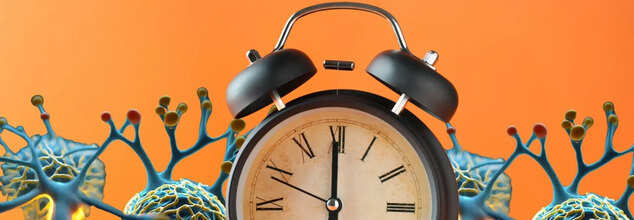- Health Conditions A-Z
- Health & Wellness
- Nutrition
- Fitness
- Health News
- Ayurveda
- Videos
- Medicine A-Z
- Parenting
Your Brain Starts Eating Itself If You Don't Sleep Enough, Research Finds

Credit: Canva
There is no denying that we've all grown up listening to idioms that refer to sleep as something unproductive. For years, society has glorified the idea of sacrificing rest to achieve more, pushing the narrative that success comes at the cost of sleep. However, as cases of sleep disorders such as insomnia, sleep apnea, and chronic fatigue increase, health experts are raising serious concerns about the repercussions of sleep deprivation. Recent research has now revealed an alarming consequence—when deprived of sleep, the brain quite literally starts eating itself.
A study published in *The Journal of Neuroscience* has uncovered that prolonged wakefulness leads to the brain consuming its own healthy cells. Researchers found that astrocytes, which are responsible for maintaining and repairing the brain, become overly aggressive in trimming unnecessary synapses. While this process is beneficial in moderation, chronic sleep deprivation causes astrocytes to over-prune, damaging essential neural connections instead of just clearing out the excess. This means that rather than helping the brain function efficiently, persistent lack of sleep triggers its deterioration over time.
Additionally, the study found that microglia—the brain’s immune cells—become hyperactive due to sleep deprivation. Normally, microglia work to clear out harmful debris, bacteria, and dead cells to protect the brain from infections and inflammation. However, when sleep is consistently disrupted, these immune cells remain in a prolonged state of activation. This sustained hyperactivity may lead to chronic inflammation in the brain, which has been linked to several neurodegenerative diseases, including Alzheimer’s and Parkinson’s.
The consequences of sleep deprivation extend far beyond just feeling fatigued. Over time, the cumulative damage caused by these changes in brain activity may accelerate cognitive decline, impair memory, and increase the risk of developing neurological disorders. Alarmingly, researchers also observed that chronic sleep loss contributes to overall brain shrinkage. This suggests that deep, consistent sleep is one of the most powerful ways to preserve long-term cognitive health and prevent irreversible damage.
It is well known that sleep plays a crucial role in clearing out toxins from the brain, consolidating memory, and regulating emotions. Losing too much of it can disrupt these essential functions, potentially leading to mood disorders such as depression and anxiety. Furthermore, studies suggest that sleep deprivation affects decision-making skills and reaction times, increasing the likelihood of accidents and poor judgment.
With the rise of digital distractions, work pressure, and social commitments, people are sleeping less than ever before. However, these new findings reinforce the importance of prioritizing quality sleep. Experts suggest that maintaining a consistent sleep schedule, reducing screen exposure before bed, and practicing relaxation techniques such as meditation or reading can significantly improve sleep quality.
While we may be tempted to trade sleep for productivity, the science is clear—skimping on rest can have serious long-term effects on brain health. If chronic sleep deprivation continues, the brain may begin to deteriorate at an accelerated pace, making it more susceptible to cognitive decline and neurodegenerative diseases. In the end, investing in proper sleep is not just about feeling rested; it’s about ensuring that the brain remains strong and resilient for years to come.
Hair Dye Ingredient Linked To Organ Failure Sparks Skin Concerns

Credits: Canva
Permanent hair dyes promise vibrant, long-lasting colour, but many contain a hidden risk: a chemical called p-phenylenediamine, or PPD. While essential for keeping hair shades bold, PPD has been linked to allergic reactions, skin inflammation, and, in rare cases, life-threatening poisoning. Experts warn that even everyday use can trigger unexpected skin issues, making awareness and caution crucial for anyone coloring their hair.
PPD in Hair Dyes: What You Need to Know
Most permanent hair dyes sold in the US and Europe contain an ingredient called p-phenylenediamine (PPD), an aromatic amine. This chemical is essential for keeping hair colour long-lasting and resistant to washing or drying. However, research increasingly links PPD to severe allergic reactions, potential cancer risks, and even life-threatening poisoning.
How PPD Affects Your Skin
Even in normal cosmetic use, the body absorbs only small amounts of PPD, but it can still trigger a variety of health issues. Allergic reactions and contact dermatitis are the most common. About 72 hours after exposure, PPD can provoke immune sensitization and inflammation, which may show up as redness, swelling, blisters, and intense itching.
People with pre-existing skin conditions such as eczema, dandruff, or other rashes are more susceptible. While 1.5% of the general population may react to PPD, this rises to 6% among those already prone to dermatitis.
PPD and Cancer Risk
The International Agency for Research on Cancer (IARC) classifies occupational exposure to hair dye as “probably carcinogenic,” but personal use hasn’t been conclusively linked to cancer. A 36-year study in 2020 found no strong association between regular hair dye use and most cancers, although it noted potential links to specific types, including estrogen receptor-negative breast cancer and basal cell carcinoma. Experts caution that these findings are not definitive and require further investigation.
Life-Threatening Risks of PPD Poisoning
While cosmetic exposure carries minimal systemic risk, ingesting PPD can be deadly. Oral exposure can cause rapid multi-organ failure, with initial signs including unpredictable swelling of the neck and airways, known as angioneurotic edema. Even with medical intervention, the mortality rate for severe PPD poisoning is around 14.5%.
Safer Alternatives and Precautions
Rising awareness of PPD’s risks has prompted the development of PPD-free dyes using alternatives like p-toluenediamine sulfate (PTDS). However, research shows that about half of individuals allergic to PPD may also react to PTDS.
The safest way to reduce risk is by performing a patch test 48 hours before every use. Professional users should wear protective gloves, and improved consumer education on potential sensitivities can further minimize danger.
How To Check If You’re Allergic To PPD
Finding out if you’re sensitive to PPD is relatively straightforward. You can visit an allergy clinic for a professional assessment, or do a patch test at home before applying any PPD-based hair dye.
What To Watch For On The Label?
PPD may appear under different names on hair dye packaging. Look out for any of the following terms, as they all indicate the presence of PPD:
- P-phenylenediamine
- Para-phenylenediamine
- 4-aminoaniline
- 1,4-benzenediamine
- p-diaminobenzene
Taking COVID And Flu Vaccines Together? Doctors Recommend Which Arm To Use

Credits: Canva
COVID-19 and influenza are major causes of illness and death worldwide, particularly in countries like the US and UK. Vaccines can prevent infection or reduce the severity of illness, yet many people struggle to stay up to date due to time constraints or lack of motivation. If you are eligible for both vaccines around the same time, combining them in a single visit can save time and effort.
Doctors suggest that receiving both vaccines at the same visit can be a convenient approach, but a common question arises: which arm should you use? Is it safe to administer both vaccines in the same arm, or is it better to use separate arms?
One Arm or Two: Which One To Use For Both Shots?
Getting both shots in one visit sounds efficient, but you still need to decide whether to use one arm or two. Often, it comes down to personal preference, although sometimes the healthcare provider will make the decision. Is there evidence to guide this choice? Should both vaccines go in the same arm or one in each?
Which Arm Works Best for COVID and Flu Vaccines?
Animal studies suggest that administering the COVID and flu vaccines in the same limb may enhance immune responses. The mRNA COVID vaccines include a built-in immune booster called an ionizable lipid, which is a fatty molecule that protects the mRNA inside the vaccine.
Flu vaccines usually lack an adjuvant, but the built-in adjuvant in the COVID shot could potentially boost the flu vaccine’s immune response if both are given in the same arm.
However, giving two shots in one arm can increase the risk of arm soreness, the most common side effect. To explore this in humans, researchers at the University of Melbourne conducted a randomized controlled trial with 56 healthy adults. The study compared giving the Moderna COVID mRNA vaccine and the CSL influenza vaccine in the same arm versus opposite arms.
Participants were randomly assigned to two groups: the “same arm” group received both vaccines in the non-dominant arm (usually the left arm for right-handed people), while the “opposite arm” group had the COVID vaccine in the non-dominant arm and the flu vaccine in the dominant arm. This setup was chosen because the COVID vaccine is more likely to cause a sore arm compared to the flu shot. Researchers collected blood, saliva, and nasal samples, and participants reported on any side effects.
Same Arm vs. Opposite Arm
The trial found no significant differences in key immune responses, such as neutralizing antibodies, whether the vaccines were given in the same arm or separate arms. Secondary analyses suggested a slightly higher immune response to COVID in the opposite arm group.
Nearly all participants reported mild arm soreness. Those in the same-arm group experienced more tenderness in that single arm, while participants in the opposite-arm group had reactions in both arms, particularly in the non-dominant arm that received the COVID vaccine.
What This Means for You
Overall, receiving both vaccines on the same day, whether in one arm or two, provides strong protection against both infections. Choosing opposite arms may slightly improve immune response and reduce soreness in any one arm, but it comes with two mildly sore arms.
For anyone looking to save time, having both vaccines in the same visit is convenient and effective. Most side effects are mild, making the benefits of dual vaccination well worth it.
5 Popular Herbal Supplements That Could Harm Your Liver

Credits: Canva
Although herbs and plants have been used for medicinal purposes for thousands of years, they have recently gained a surge in popularity, partly thanks to TikTok posts where users highlight the benefits of supplements such as ashwagandha, turmeric, and green tea.
While many consider herbal supplements “natural,” this does not automatically make them safe. Unlike prescription medicines, they do not require approval or review from the U.S. FDA before hitting the market. Users may experience side effects, and some herbs can interfere with medications they are already taking.
Can Herbal Supplements Cause Liver Damage?
Some herbal supplements can harm the liver. A recent study from the University of Michigan suggests that around 15.6 million adults in the U.S., about 5% took at least one herbal supplement in the last 30 days that may be harmful to the liver, known as hepatotoxic. This study was published in JAMA Network Open.
6 Potentially Hepatotoxic Botanical Products
Researchers analyzed data from over 9,500 U.S. adults, with an average age of 47.5, who participated in the National Health and Nutrition Examination Survey (NHANES) between 2017 and 2020. They examined participants’ use of both prescription medications and herbal supplements.
The study focused on six herbal supplements previously linked to liver toxicity:
- Ashwagandha
- Black cohosh
- Garcinia cambogia
- Green tea extract
- Red yeast rice
- Turmeric or curcumin
“Potentially hepatotoxic botanical products contain plant-based ingredients that may contribute to liver damage,” explained Alisa Likhitsup, MD, MPH, a clinical assistant professor in the Department of Internal Medicine at the University of Michigan and lead author of the study.
“How these supplements cause liver injury isn’t fully understood, but it likely involves how the liver metabolizes these products,” she added.
Data from the Drug Induced Liver Injury Network show liver injuries linked to botanical products have risen from 7% in 2004–2005 to 20% in 2013–2014.
‘Natural’ Doesn’t Always Mean Safe
After reviewing the study, Rosario Ligresti, MD, FASGE, chief of Gastroenterology at Hackensack University Medical Center in New Jersey, said that while hepatotoxic botanical products are derived from plants, the lack of oversight and testing means they may do more harm than good.
“They’re unregulated before reaching the market, so it’s not surprising that they pose significant health risks, especially to the liver. They can interfere with the liver’s ability to process and detoxify substances, potentially leading to toxin buildup, inflammation, cell death, and, in severe cases, liver failure,” Ligresti explained, as per Medical News Today.
One notable case involved a 57-year-old woman in New Jersey and New York who developed severe liver damage after taking 2,250 mg of turmeric daily since March 2025 which is far above the WHO’s safe limit of 0–3 mg per kg of body weight per day. She required hospital care for six days at NYU Langone.
Signs of liver damage can include fatigue, nausea, loss of appetite, stomach pain, and dark urine.
Ligresti emphasized that physicians should routinely ask patients about their use of herbal supplements and discuss potential liver risks.
© 2024 Bennett, Coleman & Company Limited

